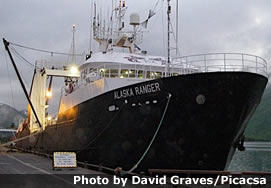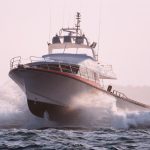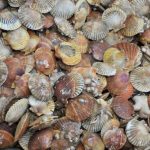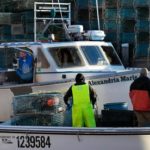Tag Archives: North Pacific Fishery Management Council
Conserving the Kenai king is a mandate for board, ADFG
Editor’s note: This is the 10th and final part of the Morris Communications series “The case for conserving the Kenai king salmon.” King salmon are the lynchpin of the Cook Inlet fishery. Other runs of other salmon species are far more abundant, but the health of king salmon affects all users. Alaska is currently experiencing historic low runs of king salmon returning to major systems throughout the state. It affects Alaskans who have fished for kings for years in these rivers and creeks, and the visitors thousands of businesses depend on every summer. Read more@juneauempire 22:26
Bering Sea Pollock Target Up for 2014
 Fishermen will be able to harvest a little more pollock from the Bering Sea next year. The North Pacific Fishery Management Council voted to bump up the catch limit to 1.267 million metric tons at a meeting in Anchorage last week. more@kmxt 17:16
Fishermen will be able to harvest a little more pollock from the Bering Sea next year. The North Pacific Fishery Management Council voted to bump up the catch limit to 1.267 million metric tons at a meeting in Anchorage last week. more@kmxt 17:16
Tribal consultation plays unofficial role in North Pacific Fishery Management Council and Board of Fisheries process
 Historical participation weighs heavily in fisheries management decisions, and Alaska Natives have thousands of years of history of fishing throughout the state, relying on salmon, halibut, crab, herring and other species for food and trade. When it comes to management, however, the oldest users report mixed success in participating in the decision-making process. more@alaskajournal 11:23
Historical participation weighs heavily in fisheries management decisions, and Alaska Natives have thousands of years of history of fishing throughout the state, relying on salmon, halibut, crab, herring and other species for food and trade. When it comes to management, however, the oldest users report mixed success in participating in the decision-making process. more@alaskajournal 11:23
North Pacific Fishery Management Council Meeting September 30 – October 8
 Agenda, (updated 9/27) September 30 – October 8, Anchorage Hilton. To listen live while the meeting is in session: npfmc.webex.com 08:43
Agenda, (updated 9/27) September 30 – October 8, Anchorage Hilton. To listen live while the meeting is in session: npfmc.webex.com 08:43
Gaming of observer program before NPFM in October
 The National Marine Fisheries Service issued a draft report on its revamped fisheries observer program after nearly a full year of implementation, and few changes are planned for 2014 although issues surrounding tendering continue. The new annual deployment plan, or ADP, does not have any major changes. In addition to predicted “gaming” where vessels in the trip-selection pool can continuously deliver to tenders without having to register for a new trip that may result in an observer on board, less information is available about salmon and halibut bycatch in deliveries to tender vessels compared to vessel deliveries to shore-side processors. more@alaskajournal 10:34
The National Marine Fisheries Service issued a draft report on its revamped fisheries observer program after nearly a full year of implementation, and few changes are planned for 2014 although issues surrounding tendering continue. The new annual deployment plan, or ADP, does not have any major changes. In addition to predicted “gaming” where vessels in the trip-selection pool can continuously deliver to tenders without having to register for a new trip that may result in an observer on board, less information is available about salmon and halibut bycatch in deliveries to tender vessels compared to vessel deliveries to shore-side processors. more@alaskajournal 10:34
Opinion: Halibut plan is best yet: Catch sharing manages uncertainty, conserves stock
 Heath Hilyard, the executive director of the Southeast Alaska Guides Organization, is right (Aug. 9, News-Miner). The halibut catch sharing plan, or CSP, isn’t about conservation. It’s about managing the charter halibut resource responsibly so businesses can operate with more certainty. In fact, the plan was supported by the charter sector many times throughout the years for that precise reason. Why the hue and cry now? They want more fish. more@newsminer 12:02
Heath Hilyard, the executive director of the Southeast Alaska Guides Organization, is right (Aug. 9, News-Miner). The halibut catch sharing plan, or CSP, isn’t about conservation. It’s about managing the charter halibut resource responsibly so businesses can operate with more certainty. In fact, the plan was supported by the charter sector many times throughout the years for that precise reason. Why the hue and cry now? They want more fish. more@newsminer 12:02
North Pacific Fishery Management Council staff defend catch sharing plan
 FAIRBANKS — A proposed plan to allocate halibut catch shares between charter and commercial boats will not necessarily lead to a one-fish per day limit for charter boat customers in waters off Southcentral Alaska, according to a summary released by North Pacific Fishery Management Council staff. more@newsminer 11:08
FAIRBANKS — A proposed plan to allocate halibut catch shares between charter and commercial boats will not necessarily lead to a one-fish per day limit for charter boat customers in waters off Southcentral Alaska, according to a summary released by North Pacific Fishery Management Council staff. more@newsminer 11:08
NOAA receives thousands of comments on catch sharing plan

National Oceanic and Atmospheric Administration–Fisheries officials estimated thousands of comments were received on the proposed halibut Catch Sharing Plan. The comment period closed Aug. 26. Officials are reviewing comments and haven’t determined a final number. more@peninsulaclarion18:35
What boats fish where in Alaska – and where they call home – Alaska Fish Radio
 Many people are surprised to learn that 80 percent of Alaska’s seafood landings come from federal waters, meaning from three to 200 miles offshore. Management oversight falls to the North Pacific Fishery Management Council and they’ve compiled a user friendly booklet profiling the fishing fleets through 2010, with an addendum for 2011 that includes names of every boat. more@alaskafishradio 16:16
Many people are surprised to learn that 80 percent of Alaska’s seafood landings come from federal waters, meaning from three to 200 miles offshore. Management oversight falls to the North Pacific Fishery Management Council and they’ve compiled a user friendly booklet profiling the fishing fleets through 2010, with an addendum for 2011 that includes names of every boat. more@alaskafishradio 16:16
North Pacific Fishery Management Council, NOAA/NMFS push controversial halibut catch sharing plan – public comments extended
 A revised version of the controversial halibut catch sharing plan is once again back up for federal review. “The fact that the CSP offers to rent back the fish that will have been stolen from the guided recreational angler strikes me as somewhat hypocritical,” Murphy said. continued@homernews
A revised version of the controversial halibut catch sharing plan is once again back up for federal review. “The fact that the CSP offers to rent back the fish that will have been stolen from the guided recreational angler strikes me as somewhat hypocritical,” Murphy said. continued@homernews
NOAA seeks public input on proposed halibut catch sharing plan
 The North Pacific Fishery Management Council recommended the catch sharing plan to establish a clear allocation between the commercial and charter sectors in Southeast Alaska and the Central Gulf of Alaska, provide stability in charter harvest, and provide halibut fishery managers with greater precision in setting halibut catch limits and management measures that are responsive to changes in halibut exploitable biomass and fishing effort. continued@sitnews
The North Pacific Fishery Management Council recommended the catch sharing plan to establish a clear allocation between the commercial and charter sectors in Southeast Alaska and the Central Gulf of Alaska, provide stability in charter harvest, and provide halibut fishery managers with greater precision in setting halibut catch limits and management measures that are responsive to changes in halibut exploitable biomass and fishing effort. continued@sitnews
Final action set for trawl fleet king salmon bycatch limit – The council meets June 5 to 11 in Juneau. Crab, cod decisions due
 As fisheries managers throughout Alaska prepare for low king salmon returns, federal regulators are considering new limits on king bycatch in the Gulf of Alaska. The North Pacific Fishery Management Council’s June agenda includes final action on a king salmon bycatch cap in the Gulf of Alaska non-pollock trawl fisheries, review of a plan to collect more information on Gulf trawl bycatch, and a discussion paper on bycatch management for the Gulf trawl fleet. continued
As fisheries managers throughout Alaska prepare for low king salmon returns, federal regulators are considering new limits on king bycatch in the Gulf of Alaska. The North Pacific Fishery Management Council’s June agenda includes final action on a king salmon bycatch cap in the Gulf of Alaska non-pollock trawl fisheries, review of a plan to collect more information on Gulf trawl bycatch, and a discussion paper on bycatch management for the Gulf trawl fleet. continued
Alaska – Compass: Commercial, charter fishermen target trawl fleet’s bycatch
 Commercial and sport fishing interests in Alaska are no strangers to allocation battles over the resources that fuel our businesses and ways of life. It’s a rare but important occasion when those of us usually on opposing sides can agree to get together to speak out for the conservation and health of the very resource we depend on. The current threat to our businesses and livelihoods we are united to address is bycatch. continued
Commercial and sport fishing interests in Alaska are no strangers to allocation battles over the resources that fuel our businesses and ways of life. It’s a rare but important occasion when those of us usually on opposing sides can agree to get together to speak out for the conservation and health of the very resource we depend on. The current threat to our businesses and livelihoods we are united to address is bycatch. continued
NPFMC fails to clarify observer program
Homer News – The Alaska Longline Fishermen’s Association’s attempt to get the North Pacific Fishery Management Council to clarify the objectives of the restructured observer program and provide a meaningful timeline for implementing the electronic monitoring program were largely unsuccessful at last week’s meeting. continued
Federal fisheries managers take another look at bycatch
 Federal fisheries managers meeting in Anchorage in early April took final action on replacement of American Fisheries Act vessels and greater quota flexibility for the flatfish fleet, and asked for yet another report on king salmon bycatch. The measure approved by the North Pacific Fishery Management Council was made by Department of Fish and Game Commissioner Cora Campbell. continued
Federal fisheries managers meeting in Anchorage in early April took final action on replacement of American Fisheries Act vessels and greater quota flexibility for the flatfish fleet, and asked for yet another report on king salmon bycatch. The measure approved by the North Pacific Fishery Management Council was made by Department of Fish and Game Commissioner Cora Campbell. continued
Flatfish flexibility OK’d; Steller sea lion EIS not ready
The North Pacific Fishery Management Council took final action on several groundfish issues, and made preliminary moves toward additional changes in the future at its April 3 to 8 meeting in Anchorage. continued
Tendering report sought after possible electronic monitoring ‘gaming’ exposed
 The North Pacific Fishery Management program heard about the status of the new marine observer program at its Anchorage meeting. continued
The North Pacific Fishery Management program heard about the status of the new marine observer program at its Anchorage meeting. continued
Bering Sea king bycatch, co-op reports and Gulf of Alaska tendering to come back before North Pacific Council
The North Pacific Fishery Management Council asked for reports and discussion papers on several items this morning, including king bycatch in the Bering Sea pollock fishery, the reports fishing cooperatives provide to the council each y ear and tendering in the Gulf of Alaska. continued
ear and tendering in the Gulf of Alaska. continued
Council to consider directed Pacific cod fishery in the Aleutians – Community Quota Entities given additional purchase opportunities
The North Pacific Fishery Management Council took quick action this morning to request a discussion paper about splitting the Pacific cod fishery in the Bering Sea and Aleutian Islands. continued
Community Quota Entities are one step close to purchasing quota share after today’s action by the North Pacific Fishery Management Council. continued
The North Pacific Fishery Management Council creates electronic monitoring working group, takes final action on flatfish flexibility, AFA vessel replacement
The North Pacific Fishery Management Council created a taskforce to discuss electronic monitoring as an option for marine observation today after significant public testimony and deliberations. continued

The council agreed to provide Amendment 80 cooperatives and Community Development Quota entities with some flexibility in its flatfish harvest each year. In another action, the council decided that American Fisheries Act, or AFA, vessel owners can rebuild or replace their vessels and still utilize Gulf of Alaska sideboards, subject to certain restrictions. In both cases, the motions for action passed unanimously. continued
Western Aleutian Processors Snag Business From Kodiak Plants. Fishing for History? Audio
Unalaska Community Broadcasting – For the past year, pollock and cod fishing off Kodiak has been booming — but processing plants in town say they aren’t seeing enough of that business. That’s because more than 14 million pounds of pollock and cod caught near Kodiak during the 2012 “B” season was shipped to plants in Akutan, King Cove, and Sand Point. continued
Council takes up crab issues – Crew provisions, active participation for quota holders
 The North Pacific Fishery Management Council took final action to increase some community protections for Bering Sea and Aleutian Islands crab fisheries today. The council discussed but did not move forward with regulatory
The North Pacific Fishery Management Council took final action to increase some community protections for Bering Sea and Aleutian Islands crab fisheries today. The council discussed but did not move forward with regulatory  action regarding captain and crew protections in the Bering Sea and Aleutian Islands crab fisheries. The two discussion papers on those issues talked about participation requirements for quota shareholders, and cooperative measures to address crew issues. Read more here
action regarding captain and crew protections in the Bering Sea and Aleutian Islands crab fisheries. The two discussion papers on those issues talked about participation requirements for quota shareholders, and cooperative measures to address crew issues. Read more here
North Pacific Council talks economic data collection – vessel replacement for American Fisheries Act boats in the Gulf of Alaska
PORTLAND, Ore. — The North Pacific Fishery Management Council discussed how it will evaluate central Gulf of Alaska rationalization today. Read more here 

The North Pacific Fishery Management Council took action this morning to continue working on vessel replacement for American Fisheries Act boats in the Gulf of Alaska. Read more here
Council takes final action on skate habitat protections
 The North Pacific Fishery Management Council made quick work of a number of issues today, taking final action on skate habitats and doing the initial review of other habitat and groundfish issues. Read more here
The North Pacific Fishery Management Council made quick work of a number of issues today, taking final action on skate habitats and doing the initial review of other habitat and groundfish issues. Read more here
Fishermen file suit over salmon management
United Cook Inlet Drift Association and Cook Inlet Fishermen’s Fund filed suit in District of Columbia District Court Jan. 18 over the transfer of salmon management from federal authorities to the state of Alaska.
Skates, crab quota transfers, Gulf rationalization on tap, Molly Dischner – Portland, Ore., meeting Feb. 6-12
 The North Pacific Fishery Management Council is poised to take final action on skate habitat designations and community rights for Bering Sea and Aleutian Island crab fisheries at its Portland, Ore., meeting Feb. 6-12. The council will also talk about a possible rationalization program for the Central Gulf of Alaska, or GOA. The February agenda includes two discussion papers on that issue — one on trawl economic data collection, and one on trawl catch shares. There’s also an agenda item to review the issues that will arise for Western GOA fishermen as the Central GOA is rationalized, something that the council has heard testimony on at prior meetings. Read more here
The North Pacific Fishery Management Council is poised to take final action on skate habitat designations and community rights for Bering Sea and Aleutian Island crab fisheries at its Portland, Ore., meeting Feb. 6-12. The council will also talk about a possible rationalization program for the Central Gulf of Alaska, or GOA. The February agenda includes two discussion papers on that issue — one on trawl economic data collection, and one on trawl catch shares. There’s also an agenda item to review the issues that will arise for Western GOA fishermen as the Central GOA is rationalized, something that the council has heard testimony on at prior meetings. Read more here
I missed this one. AJOC EDITORIAL: State should foot the bill for salmon disaster
 The first fishery management plan approved after the passage of the original Magnuson Act in 1976 was the Alaska salmon FMP delegating that responsibility to the Department of Fish & Game. After revisions to what later became the Magnuson-Stevens Act were passed in 2006, all FMPs were required to be updated within five years to meet new requirements for setting annual catch limits and accountability measures….The result was the North Pacific Fishery Management Council amending the salmon FMP in 2011 to officially remove waters near Cook Inlet, Prince William Sound and the Alaska Peninsula from federal control. The only state-managed salmon fishery that officially remains within the federal FMP is the Southeast salmon troll fishery that must be managed in accord with the Pacific Salmon Treaty between the U.S. and Canada. Read more
The first fishery management plan approved after the passage of the original Magnuson Act in 1976 was the Alaska salmon FMP delegating that responsibility to the Department of Fish & Game. After revisions to what later became the Magnuson-Stevens Act were passed in 2006, all FMPs were required to be updated within five years to meet new requirements for setting annual catch limits and accountability measures….The result was the North Pacific Fishery Management Council amending the salmon FMP in 2011 to officially remove waters near Cook Inlet, Prince William Sound and the Alaska Peninsula from federal control. The only state-managed salmon fishery that officially remains within the federal FMP is the Southeast salmon troll fishery that must be managed in accord with the Pacific Salmon Treaty between the U.S. and Canada. Read more











































Fisheries of the E E Z Off Alaska; Amendment 95 to the FMP for Groundfish – comment period ends (10/28/2013)
Share this post